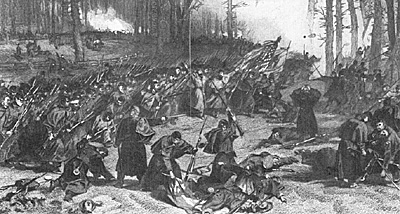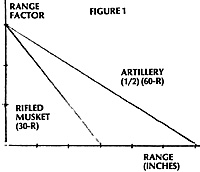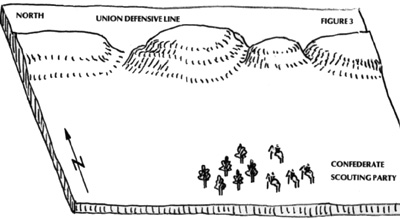INTRODUCTION
 The American Civil War battle described in this article
used an assortment of home-cast 35mm figures that
started life as members of a British line battalion, circa
1900, produced by an Ohio firm.
The American Civil War battle described in this article
used an assortment of home-cast 35mm figures that
started life as members of a British line battalion, circa
1900, produced by an Ohio firm.
Because of their size, conversion is relatively simple, and the ACW figures, while definitely not to be classified as objets d'art, are more than sufficient for skirmish gaming.
Infantrymen are single mounted on 1 inch square stands. Cavalry are based on a 1 X 2 inch stand, and each mounted trooper has his counterpart in a dismounted figure. There is also a great deal of use made of casualty figures, since a man, when hit, may either be killed outright, or merely be "out of action" for several turns.
THE FIRING SYSTEM
Missile weapons, i.e., muskets and cannon, are assigned range factors. If R denotes the measured range in inches, the range factor, RF, for musketry is (30 - R), while that for artillery is (60 - R)/2. This permits the artillery to reach out, on a scale of 1 inch equals 10 yards, to 600yards, and limits small armsto300yards.
 The chart of Figure 1 shows that at point-blank range,
i.e., zero range, both weapons have range factors of 30.
The chart of Figure 1 shows that at point-blank range,
i.e., zero range, both weapons have range factors of 30.
While the rifled musket factor dies down to zero at 30 inches, the artillery is still quite a potent weapon at this range, with a range factor of 15.
The weapons effect depends upon 3 factors: Range factor (RF), the time period during which fire occurs (T) and the number of men firing (N).
The weapons effect is given in terms of Casualty Points (CP): CP = RF x T x N
In our skirmish games, the commander has control of the time period during which his troops move or fire. If, for example, he chooses to fire for 2 periods, then a unit of 5 men i.e., 5 castings, firing at a range of, say, 11 inches, inflicts:
CP = (30 - 11) X (2 periods) X (5 men) CP = 190
Every 100 CP translates into a "kill die". The 190 points thus become 1 kill die plus 90 percent chance of a second die.
A "kill die" is a 10-sided die, which, when rolled, produces:
1 to 7 2,4,6, man killed; 1,3,5,7, man is out of action 8 to 10 No effect
A man designated "out of action" is replaced by a prone casualty figure; he may try to rise to his feet, each turn, with 50% chance of success. If he does so, he's good as new, unwounded.
Cover modifiers are provided by adjusting the kill die roll:
Add 2 for target under hard cover. Add 1 for target under soft cover.
Looking at the statistics of the firing procedure, first note that the average number of increments is 2. Assume one man fires at the midpoint of his musket's range, 15 inches, and that he fires for 2 increments:
CP = (30 - 15) X (2 periods) X (1 man) CP = 30
Thus the single man has 30% chance of getting a kill die, which, when thrown, gives him 70% chance of causing a casualty. At this mid-range point, therefore, there is a .3 X .7, or 21% chance for one man to fire effectively.
The maximum probability of hit occurs at zero range, when the man fires for 3 increments. In this case, there is a 90% chance to hit.
THE MOVEMENT SYSTEM
The time periods previously mentioned, termed increments, are determined by each commander alternately selecting a card from an assigned 5 card deck. Each deck has an assortment of 1, 2, or 3-increment cards in it:
| No of Cards | No of Increments
Denoted on Card |
|---|---|
| 2 | 1 |
| 1 | 2 |
| 2 | 3 |
The commander draws his desired increment card, and moves all his forces. During each increment, units may do the following:
Infantry move 3 inches Infantry and Cavalry may fire Cavalry may move 6 inches Cavalry may mount or dismount Limbered artillery may move 6 inches
Unlimbered artillery may move 3 inches
Artillery crewmen may fire or load their weapon (not both)
Artillery crewmen may pivot their weapon to concentrate on a new target
Thus on a 3-increment card, an infantry unit could fire, fire, and fire again, thus getting in 3 full increments of fire. Or they could move forward 3 inches on the first increment, 3 inches on the second, andfireon thethird. Or a cavalry unit could move 6 inches on the first increment, dismount on the second, and fire on the third. And so on ..
MELEE
Kill dice are also used in the melee procedures. Here, once a charge is declared, the attacking unit is moved halfway to the point of contact and, at this point, the defending unit checks its morale to see if it stands and fires.
If the unit's morale fails, the defenders are turned in place, backs to the enemy, and the attackers surge forward into contact, swinging their swords or bayonets or whatever, for a "free hack". The unfortunate defenders, on their next 2 card draws, run pell mell to the rear, where they may recover. Since they run for 2 card draws, they may be pursued and hacked at again by the victors, unless the defense can bring up other units to protect the routers.
If, at the halfway point in the charge, the defending unit passes its morale check, it gets to fire at the oncoming attackers. Note that this is a "free fire" for the defenders, since it occurs on the attacker's card. The "free fire", therefore, is limited to one increment's worth. Casualties caused by this fire now require a morale check by the attackers.
Should both sides pass their morale checks, the attackers are brought into contact, one-on-one, and hand-to-hand takes place. If the attackers outnumber the defenders, two-on-one combats are permitted, but no more than two-on-one.
All combat modifiers are given as "plus tens", that is, a man may get a +10 for being mounted, +10 for elite, +10 for uphill, etc. No negative modifiers are used . . . if a man is at a disadvantage, he doesn't get a minus, his opponent receives a benefit of + 10.
The modifiers for both sides are totaled and the difference, D, is taken and added to the base figure value of the side with the highest total. Depending upon the type if combat, there are 2 possible base values per figure: (a) if "like meets like" (infantry versus infantry, or cavalry versus cavalry) the base value is 25; (b) in a cavalry versus infantry battle, the base value is 15.
Thus if an elite unit of cavalry charges uphill at the flank of infantry, the cavalry receive +10 for elite, +10 for impact, +10 for flank, and +10 for being mounted, while the infantry receive +10 for uphill. The difference in the totals, D, is 40 -.10, or 30 in favor of the cavalry.
CONFEDERATE Information Sheet
1. Your force of cavalry and infantry have been assigned to break through the Union lines.
2. You must place one 5-man cavalry scouting force on the field, after which the Union forces will set up. You may then come on the field anywhere along your baseline.
3. Your Headquarters Company has several unarmed men in reserve who may be sent to replace casualties in your units.
4. Cavalry troopers take 1 increment of movement to mount or dismount. One man must be assigned as a horse holder, or the horses will bolt. The horse holder may take care of 10 horses.
UNION Information Sheet
1. You have been informed that there is a Confederate force in the area attempting to breakthrough your lines.
2. You may set up your forces as far forward as the ridge line. You must set up before the main Confederate force appears, but after one Confederate scouting party is placed on the field.
3. Your Headquarters Company has several unarmed men in reserve who may be sent to replace casualties in your units.
4. You have 4 cannon, but only 4 rounds, in all, of ammunition. You may set your guns and allocate your ammunition in any way desired. After your guns run out of ammunition, the artillery crewmen may report to the Headquarters Company to act as reserves.
This difference D is now added to the base value of 15 giving the cavalry 45 points per figure; the infantry remain at the base value of 15.
If, in the example, 5 cavalrymen contact 5 infantry, the total for the cavalry is 5 X 45 or 225, while the infantry has 5 X 15 or 75. These point totals are now used as in the firing procedures to obtain the kill dice for both sides. The cavalry unit, therefore, gets 2 kill dice plus 25% chance at a second.
Morale checks are made after each round of combat until one or both sides break.
THE BATTLE
 A scenario set up at a Potomac Wargamer's meeting had
8 companies, each of 5 men, on each side. The
Confederates had 5 companies of infantry, 3 of cavalry, while
the Union had no cavalry.
A scenario set up at a Potomac Wargamer's meeting had
8 companies, each of 5 men, on each side. The
Confederates had 5 companies of infantry, 3 of cavalry, while
the Union had no cavalry.
The Union did have artillery, but it was purposely "defused" as a reading of the information sheets in Figure 2 will show.
Note that the Confederates, with the same size force as the Yankees (less, if one counts the Union artillery), were tasked with attacking. This was not considered a disproportionate force assignment because the Union command had to defend an 8 foot baseline from being penetrated. The Union force would, it was thought, be thinly dispersed all along the battle line, while the Confederates had the advantage of, first, being able to view the Yankee disposition, and second, being able to mass at any point desired for their break-through. The playing field measured 8 x 4 feet and is shown in Figure 3.
It had been anticipated that the Union commander would mass his 4 fairly impotent cannon in an imposing looking grand battery on one flank to dissuade the Rebels from attacking that sector, thus funneling the attack towards the defending Union infantry.
This proved not to be the case. The 4 guns were evenly distributed all along the ridge line, as were the infantry. Three rounds were allotted the most western cannon on the Union right flank; the remaining round was given to the eastern left flank gun. The guns in the middle, therefore, were only for show.
The Confederate commander, Cuhnel R. E. Lee, saw before him 8 feet, approximately 112 mile, of ridge line and decided to attack on both flanks. Four companies on his right flank in the east, and 3 in the west on his left flank, with cavalry composing 2 of the 3 units in the western force. The third cavalry company entered the field in the center . . . this was the advance scouting force.
The Union commander, Major Lincoln, when he saw the Confederate disposition, immediately began moving his men towards the flanks, leaving the center bare.
Cuhnel Lee led with his cavalry; his 2 left flank mounted units charged forward, leaving the infantry unit behind. On a 3-increment card, the cavalry move 18 inches, and the 30 inch rifled musket range means that the defenders will get in at least 2 blasts at mounted troopers before they can make contact.
The analysis of the hit procedures showed that, depending upon the range and whether 1 man fires, or all 5 in a company fire, each man may inflict from zero to 1 casualty every time he pulls the trigger. The average, at close range, is .35 casualties per "shot" . . . it may be more.
In the case of Cuhnel Lee's cavalry charge, it was more. The Cuhnel had carefully reserved his 3-increment cards to ensure that his cavalry covered ground a rapidly as possible . . . but it was no use; the kill dice of the defending Union infantry proved too effective. The cavalry never made contact; on their morale check 2survivors of the 10 men that commenced the charge routed back, and were never heard from again.
Whenever a company was required to test morale, the morale level was defined as:
Morale Level (%) = 40 + [(10) X (Number of Men)]
Thus each 5 man company started out with a morale level of 90%, while a single survivor was down to 50% chance of standing under stress.
The rapid demise of the cavalry was aided by the fact that those unfortunate units had chosen to attack the cannon that had been allotted 3 of the 4 total Union artillery rounds. Some days, it just doesn't pay to get out of bed.
Undaunted by the fate of the 2 cavalry units, the remaining Confederate company tried to take up the slack. Cuhnel Lee's plan was to keep as many defending units as possible busy in the west while the big push was made on the eastern edge of the field.
Here, in the east, for several turns the Cuhnel's right flank force traded long range fire with the Union. The Confederates got the worst of this, since the defenders had the advantage of a cover modifier on the ridge.
But there was method to the Cuhnel's madness. Major Lincoln, seeing his opponent stationary, and firing at a disadvantage, continued to move his units from the center of the field to the east to reinforce the 2 companies originally assigned to that sector. In doing so, however, he left his center bare of any defense except 2 empty cannon.
After 3 or 4 turns of fire, the Cuhnel was satisfied . . . his eastern force commenced to move forward. Seeing the advance, Major Lincoln redoubled his efforts to support his left flank.
The Cuhnel, then, with the help of several 3-increment cards sent forth his reserve 5 man cavalry scouting unit straight to the north and up the center of the board.
Each time the Union drew its card, the Cuhnel winced; he expected the 2 guns defending the middle to open fire at any time. The Union commander was wincing, too; as the cavalry approached, he realized he had been taken ... there was no one to oppose the Confederate horsemen, since all of his units had been transferred to the flanks.
And that's the way the encounter ended. The 5 southern mounted troopers broke through and reached the northern baseline. Instant victory.
FINAL THOUGHTS
The commander's use of increment cards to control his troops' actions is representative of the fact that not all the time will his men perform as rapidly and as smartly as desired.
A volley is ordered, and, in some instances, the fire is ragged and ineffective, in others, it is very efficient. The former results when a 1-increment card is played, while the latter stems from the display of 3-increments. An advance is called for and the troops move up quickly (3- increments); a turn or so later and the order to advance only results in a slow shuffle (1-increment). Since the commander can choose his cards, he has, at first,a certain amount of control, but this is limited by the number of allotted increments.
There are 2 ways to look at the increment system. The first method looks at each CARD, whether of 1, 2, or 3 increments, as representing a specific time span. Troops react sharply, fire rapidly, etc., when a 3increment card is drawn. They slow down to a lesser efficiency when a 1- increment appears. Here the bound length is constant and the troops' reaction is the variable which changes from card to card.
The second method of viewing the incremental system is to envision each INCREMENT as a specific period of time. Thus, when 3-increments are drawn, the encompassed time span represents a period 3 times as long as that of a 1-increment card. In essence, then, the commander has control of the LENGTH of the bound. 'Till now, wargame rules have traditionally used a fixed period bound . . . but there is no reason, other than tradition, for sticking to this concept. To date, only EMPIRE III by Bowden, and CODE NAPOLEON by Jeffrey have gotten away from the fixed bound system.
Back to Table of Contents -- Courier Vol. V #4
To Courier List of Issues
To MagWeb Master Magazine List
© Copyright 1984 by The Courier Publishing Company.
This article appears in MagWeb (Magazine Web) on the Internet World Wide Web.
Other military history articles and gaming articles are available at http://www.magweb.com